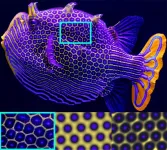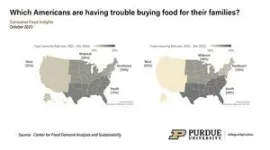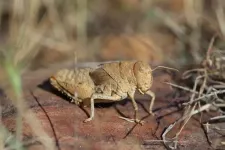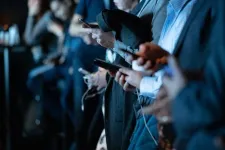(Press-News.org) Nature has no shortage of patterns, from spots on leopards to stripes on zebras and hexagons on boxfish. But a full explanation for how these patterns form has remained elusive.
Now engineers at the University of Colorado Boulder have shown that the same physical process that helps remove dirt from laundry could play a role in how tropical fish get their colorful stripes and spots. Their findings were published Nov. 8 in the journal Science Advances.
“Many biological questions are fundamentally the same question: How do organisms develop complicated patterns and shapes when everything starts off from a spherical clump of cells,” said Benjamin Alessio, the paper’s first author and an undergraduate researcher in the Department of Chemical and Biological Engineering. “Our work uses a simple physical and chemical mechanism to explain a complicated biological phenomenon.”
Biologists have previously shown that many animals evolved to have coat patterns to camouflage themselves or attract mates. While genes encode pattern information like the color of a leopard’s spots, genetics alone do not explain where exactly the spots will develop, for example.
In 1952, before biologists discovered the double helix structure of DNA, Alan Turing, the mathematician who invented modern computing, proposed a bold theory of how animals got their patterns.
Turing hypothesized that as tissues develop, they produce chemical agents. These agents diffuse through tissue in a process similar to adding milk to coffee. Some of the agents react with each other, forming spots. Others inhibit the spread and reaction of the agents, forming space between spots. Turing’s theory suggested that instead of complex genetic processes, this simple reaction-diffusion model could be enough to explain the basics of biological pattern formation.
“Surely Turing’s mechanism can produce patterns, but diffusion doesn’t yield sharp patterns,” said corresponding author Ankur Gupta, an assistant professor in the Department of Chemical and Biological Engineering. For instance, when milk diffuses in coffee, it flows in all directions with a fuzzy outline.
When Alessio visited the Birch Aquarium in San Diego, he was impressed by the sharpness of the boxfish’s intricate pattern: It’s made of a purple dot surrounded by a distinct hexagonal yellow outline with thick black spacing in between. Turing’s theory alone would not be able to explain the sharp outlines of these hexagons, he thought. But the pattern reminded Alessio of computer simulations he had been conducting, where particles do form sharply defined stripes. Alessio, a member of the Gupta research group, wondered if the process known as diffusiophoresis plays a role in nature’s pattern formation.
Diffusiophoresis happens when a molecule moves through liquid in response to changes, such as differences in concentrations, and accelerates the movement of other types of molecules in the same environment. While it may seem like an obscure concept to non-scientists, it’s actually how laundry gets clean.
One recent study showed that rinsing soap-soaked clothes in clean water removes the dirt faster than rinsing soap-soaked clothes in soapy water. This is because when soap diffuses out of the fabric into water with lower soap concentration, the movement of soap molecules draws out the dirt. When the clothes are put in soapy water, the lack of a difference in soap concentration causes the dirt to stay in place.
The movement of molecules during diffusiophoresis, as Gupta and Alessio observed in their simulations, always follows a clear trajectory and gives rise to patterns with sharp outlines.
To see if it may play a role in giving animals their vivid patterns, Gupta and Alessio ran a simulation of the purple and black hexagonal pattern seen on the ornate boxfish skin using only the Turing equations. The computer produced a picture of blurry purple dots with a faint black outline. Then the team modified the equations to incorporate diffusiophoresis. The result turned out to be much more similar to the bright and sharp bi-color hexagonal pattern seen on the fish.
The team’s theory suggests that when chemical agents diffuse through tissue as Turing described, they also drag pigment-producing cells with them through diffusiophoresis— just like soap pulls dirt out of laundry. These pigment cells form spots and stripes with a much sharper outline.
Decades after Turing proposed his seminal theory, scientists have used the mechanism to explain many other patterns in biology, such as the arrangement of hair follicles in mice and the ridges in the roof of the mouth of mammals.
Gupta hopes their study, and more research underway by his research group, can also improve the understanding of pattern formation, inspiring scientists to develop innovative materials and even medicines.
“Our findings emphasize diffusiophoresis may have been underappreciated in the field of pattern formation. This work not only has the potential for applications in the fields of engineering and materials science but also opens up the opportunity to investigate the role of diffusiophoresis in biological processes, such as embryo formation and tumor formation,” Gupta said.
END
How animals get their stripes and spots
2023-11-08
ELSE PRESS RELEASES FROM THIS DATE:
A fifth of European Red List flora and fauna species may be at risk of extinction
2023-11-08
A new analysis of 14,669 threatened species of plants and animals found in Europe reveals that about one fifth face the risk of extinction, and that agricultural land-use change poses a significant threat to these species. Axel Hochkirch of the Musée National d’Histoire Naturelle, Luxembourg, and colleagues present these findings in the open-access journal PLOS ONE on November 8, 2023.
The variety of species of living things—biodiversity—is declining around the world, as more and more species face the risk of extinction. Many efforts, including some by governments and nonprofit organizations, aim to reduce the loss ...
Head lice evolution mirrors human migration and colonization in the Americas
2023-11-08
A new analysis of lice genetic diversity suggests that lice came to the Americas twice – once during the first wave of human migration across the Bering Strait, and again during European colonization. Marina Ascunce, currently at the USDA-ARS, and colleagues, report these findings in a new study published November 8 in the open-access journal PLOS ONE.
The human louse is a wingless, blood-sucking parasite that lives its entire life on its host. It is one of the oldest known parasites to live on humans, and the two species have coevolved ...
A digital detox may not improve wellbeing: social media users who reduced their use for a week saw decreases in positive emotions as well as in negative ones
2023-11-08
A digital detox may not improve wellbeing: social media users who reduced their use for a week saw decreases in positive emotions as well as in negative ones
###
Article URL: https://journals.plos.org/plosone/article?id=10.1371/journal.pone.0293467
Article Title: Restricting social networking site use for one week produces varied effects on mood but does not increase explicit or implicit desires to use SNSs: Findings from an ecological momentary assessment study
Author Countries: UK
Funding: This work was supported by the Economic and Social Research ...
Financial traders may seek better sleep by self-medicating with caffeine and alcohol to balance the effects of the stimulant and the sedative, per micro-longitudinal study
2023-11-08
Financial traders may seek better sleep by self-medicating with caffeine and alcohol to balance the effects of the stimulant and the sedative, per micro-longitudinal study
###
Article URL: https://journals.plos.org/plosone/article?id=10.1371/journal.pone.0291675
Article Title: Sleep, alcohol, and caffeine in financial traders
Author Countries: USA
Funding: The authors received no specific funding for this work. END ...
Autism brain states hold the key to unlocking childhood memories
2023-11-08
Neuroscientists have discovered a fascinating connection between the retention of early life memories and brain developmental trajectories associated with autism [Wednesday 8th November 2023].
Most of us remember little of our experiences from before two years of age. This form of memory loss, termed “infantile amnesia” refers to the seemingly complete loss of episodic and autobiographical memories formed during early life. The research team at Trinity College Dublin investigated how infantile amnesia is affected by forms of autism.
The maternal immune response, sparked into life in response to infection during pregnancy, ...
Artificial bladders shine light on bugs that cause urinary tract infections
2023-11-08
The research, published today in Science Advances, is the first to use a sophisticated human tissue model to explore the interaction between host and pathogen for six common species that cause urinary tract infections. The findings suggest that the ‘one size fits all’ approach to diagnosis and treatment currently used in most healthcare systems is inadequate.
Urinary tract infection (UTI) is a growing problem, with around 400 million global cases per year and an estimated 250,000 UTI-related deaths associated with antimicrobial resistance ...
Temperature increase triggers the viral infection
2023-11-08
Researchers at Lund University, together with colleagues at the NIST Synchrotron Facility in the USA, have mapped on an atomic level what happens in a virus particle when the temperature is raised.
"When the temperature rises, the virus's genetic material changes its form and density, becoming more fluid-like, which leads to its rapid injection into the cell," says Alex Evilevitch a researcher at Lund University who led the study.
Viruses lack their own metabolism and the ability to replicate independently; they are entirely dependent on a host cell to multiply. Instead, the virus hijacks the internal machinery of the infected cell ...
Molecule tested at University of São Paulo, in Brazil, proves able to mitigate heart failure
2023-11-08
Researchers at the University of São Paulo (USP) in Brazil, partnering with Foresee Pharmaceuticals, a Taiwan and US-based biopharmaceutical company, have tested a synthetic molecule for the treatment of heart failure. The study, funded by FAPESP, was published yesterday (11/07/2023) in the European Heart Journal. The theme was also highlighted in the magazine's editorial.
Heart failure is a condition in which the heart muscle cannot pump enough blood to meet the body's needs for blood and oxygen. It causes more deaths worldwide than any other disease, in the sense that other cardiovascular disorders ...
How mice choose to eat or to drink
2023-11-08
Making decisions is hard. Even when we know what we want, our choice often leaves something else on the table. For a hungry mouse, every morsel counts. But what if the decision is more consequential than choosing between crumbs and cheese?
Stanford researchers investigated how mice resolve conflicts between basic needs in a study published in Nature on Nov. 8. They presented mice that were both hungry and thirsty with equal access to food and water and watched to see what happened next.
The behavior of the mice surprised the scientists. Some gravitated first ...
Plant lifecycle insights: Big data can predict climate change impact
2023-11-08
The study is based on a new database created by the researchers which combines, for the first time, datasets on distribution and datasets on lifecycles, making it possible to establish the prevalence of different lifecycles around the globe. It uses empirical tools and big data to examine theoretical paradigms about the way in which human disturbance is affecting annual plants and their global distribution. Among other things, it was found that annuals are expected to benefit more with the rise in human population density and due to climate change, which ...







